Posted June 25, 2018 in
A full tummy tuck addresses three problems: excess skin, excess fat, and abdominal wall laxity. I perform the vast majority of full tummy tucks through a curved horizontal lower abdominal incision and an incision around the umbilicus (belly button). Through this incision, I remove a horizontal ellipse that includes all of the skin from the belly button to the pubic area.
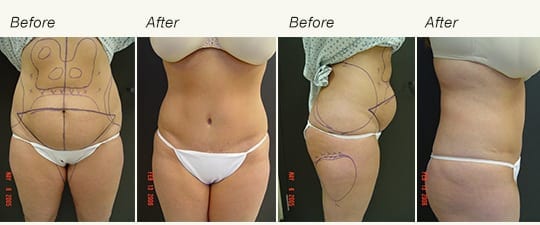
**This patient had a tummy tuck along with liposuction of her love handles, inner and outer thighs.
There are two subsets of patients who may benefit from a vertical incision:
- The patient with too little skin excess. The tummy tuck patient who doesn’t have quite enough vertical skin excess may benefit from a LIMITED vertical incision. This is usually a woman who has had two or more children and has a stretched-out abdomen that makes her still look pregnant—but paradoxically does not that much extra skin. If the amount of vertical skin excess is insufficient, then the ellipse of removed skin cannot extend all the way up to the belly button. So a small vertical incision will be necessary to remove the skin around the belly button. This is usually a decision made during the course of surgery, depending on the tightness of the skin closure.
 ** Tummy tuck with liposuction of love handles. Arrow pointing to small vertical scar.
** Tummy tuck with liposuction of love handles. Arrow pointing to small vertical scar.
- The patient with way too much skin excess. These are nearly always men and women who have had a major weight loss due to bariatric surgery or aggressive dieting and exercise. I still manage the vast majority of these patients through a horizontal incision. In patients whose complaints are limited to the abdomen, a “standard” tummy tuck (with a horizontal incision) is used; in patients whose complaints include skin laxity of the “love handles” and back, a full body lift may be used (which still entails a horizontal incision).
 **Tummy tuck. Arrow pointing to small vertical scar.
**Tummy tuck. Arrow pointing to small vertical scar.
 **Full body lift, early post-op
**Full body lift, early post-op
An EXTENDED vertical incision is sometimes utilized in full tummy tucks when there is so much “side-to-side” skin excess in the upper abdomen that it cannot be addressed by a standard tummy tuck. This type of tummy tuck is often called a “fleur-de-lis.” Although it is very effective in removing severe skin excess, I rarely perform this procedure. Why?
- Delayed wound healing. The junction between the horizontal scar and the vertical scar is an area of reduced blood flow. This increases the risk of wound infection, tissue loss, delayed wound healing, and poor scarring.
- Unsatisfactory scarring. Most horizontal abdominal scars are quite acceptable; many are surprisingly inconspicuous. In contrast, lengthy vertical abdominal scars are usually elevated, widened, and unattractive.
 **Surgery not performed by Dr. FriedmanThe bottom line: the vast majority of tummy tucks can be performed safely and effectively through a curved horizontal lower abdominal incision (and an incision around the umbilicus). However, there is a limited subset of patients for who may benefit from a vertical incision.
**Surgery not performed by Dr. FriedmanThe bottom line: the vast majority of tummy tucks can be performed safely and effectively through a curved horizontal lower abdominal incision (and an incision around the umbilicus). However, there is a limited subset of patients for who may benefit from a vertical incision.
If you have any questions or wish to schedule a consultation feel free to call our office at (469) 467-0100, or fill out our contact form.
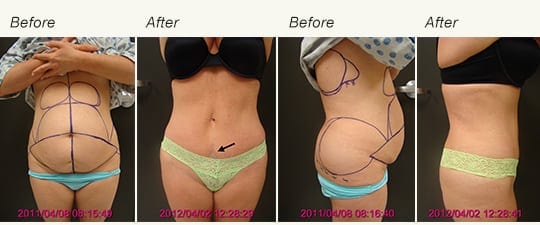 ** Tummy tuck with liposuction of love handles. Arrow pointing to small vertical scar.
** Tummy tuck with liposuction of love handles. Arrow pointing to small vertical scar.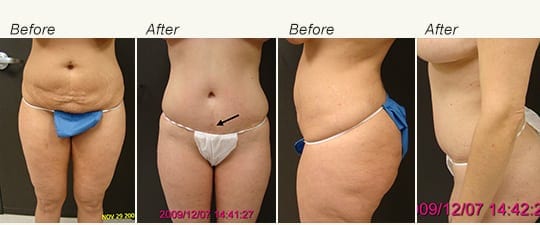 **Tummy tuck. Arrow pointing to small vertical scar.
**Tummy tuck. Arrow pointing to small vertical scar.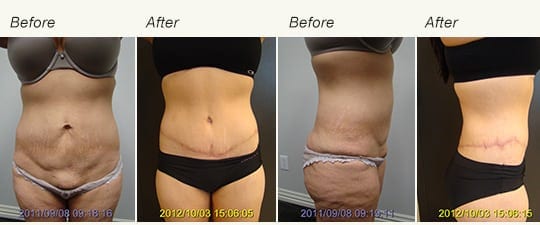
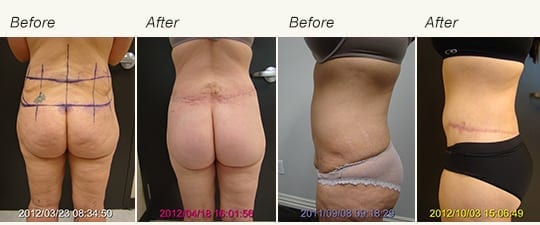 **Full body lift, early post-op
**Full body lift, early post-op **Surgery not performed by Dr. FriedmanThe bottom line: the vast majority of
**Surgery not performed by Dr. FriedmanThe bottom line: the vast majority of